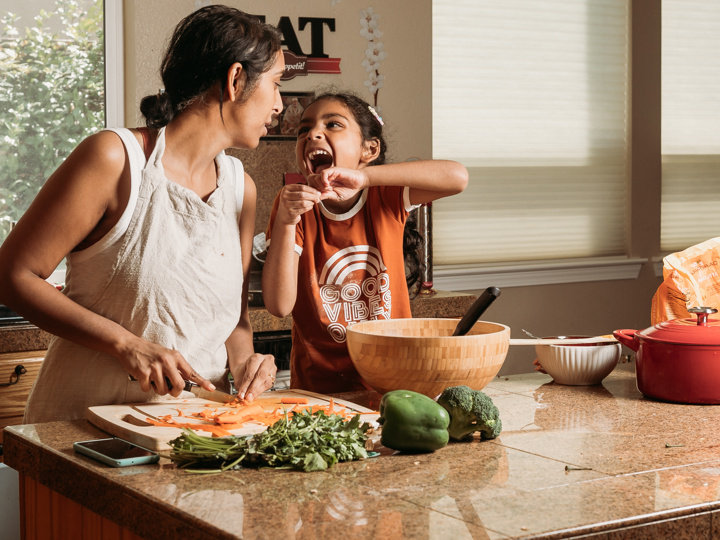Helping your child to accept new foods
- Feeding and eating

Some children and young people can struggle with new foods. They may have a small number of 'safe' foods that they feel comfortable with eating. Some children and young people can be scared when new foods are introduced. Repeatedly exposing or offering them a small amount of a new food can help them to overcome their fear of some foods.
Explore the topics on this page:
Introducing new foods
When introducing a new food, try to be aware of your child or young person's stress. Only offer a small amount of the new food. Try to separate the new food from the rest of the meal by placing it on a separate plate or bowl. This means that the new food won't touch the 'safe' food. This helps to give them control over whether or not they eat the new food. Encourage your child to explore this food with their senses, such as looking at the food, smelling the food and touching the food. This is called the 6 steps to eating. Repeat this with small amounts of the new food as regularly as allowed to get them used to the food.
Separating a meal into different parts can help some sensitive children and young people. For example, if you are having a chicken curry offer them the plain chicken with the curry sauce on the side. This gives your child or young person control over how they wish to eat the curry.
You can also offer new foods in different ways. For example, carrots can be grated, sliced, steamed, roasted or fried.
If offering new foods at mealtimes is too disruptive or stressful, think about offering them new foods at a different time of the day. This could be whilst cooking a meal, at snack time, or during a picnic.
It’s a good idea to discuss this plan with your child wherever possible, so they know what is going to happen. Ask them to choose the types of food they would like to try. It might help to choose foods that are similar in appearance or texture to their liked or safe foods.
Tips to help develop food acceptance
Do:
- talk about food positively
- create a calm and low pressure atmosphere at mealtimes
- talk about the different sensory elements like colour, feel and smell
- role model by showing how much you are enjoying your food and eating together
- explain 'you don't have to eat it but just tasting, chewing, spitting and licking counts.'
- show foods in Tupperware containers or plain plastic bags rather than the original packaging, this prevents your child or young person developing a preference to a specific brand
Do not:
- do not put too much pressure on your child or young person
- do not use judgemental language when talking about food, avoid using terms like 'good' or 'bad' food
- do not comment on how much your child or young person is eating as this can be discouraging
- do not wipe or clean your child's mouth when they are eating
- do not offer food as a reward for tasting
- do not give up, even if your child refuses for several days in a row
Taste Time - a guide to gradual food exposure
Taste time is a method that can help encourage your child to try foods they don't like. It uses something called the repeated exposure technique to help even the fussiest eaters try new foods.
Research shows that it can take 10 tries before a child is willing to try a new vegetable. The more a child sees and tries different vegetables, the more likely they are to eat them. This method can work for children of any age.
- This method uses a sticker based approach to encourage your child to try different foods. If you think your child is too old for this method of reward, then you can still use the principles of regular food exposure but choose more suitable rewards to offer when your child meets their goal for trying food.
- Choose a food for your child to try. Or if your child is old enough you can choose a food together. Try not to choose foods that they really don’t like, if they are reluctant then choose foods similar in appearance and texture to liked foods.
- Using the taste time chart write your child’s name and the food they are going to play the game with. Or you can let them do it themselves. It can help to explain to your child ‘we're going to play this game every day, and each time you taste the food, you will get a sticker and we can tick the box on the chart'.
- Choose a regular time to play the game. Snack time and just before a mealtime are good times to try. Try to avoid doing it at mealtimes.
- Try to get your child involved. If it’s a vegetable, show them the whole vegetable and talk about where it comes from or how it grows. When you're preparing the food, try to let your child help.
- Cut a small piece of the food, no bigger than a 5p coin. Ask your child to put it in their mouth and taste it. It’s important they taste it, but it's ok if they spit it out the first few times.
- If they taste the food, put a tick on the chart for that day and praise them for tasting it. If it's appropriate, let them choose a sticker. If they refuse to taste it, put a cross on the chart, but don't give a sticker. Calmly say, 'We'll try again tomorrow.'
- Repeat this with the same food every day for 14 days. Don’t worry if you miss a day, just carry on the next day. If you stop for more than a few days, you may need to start again.
Last reviewed: 1 November, 2024

